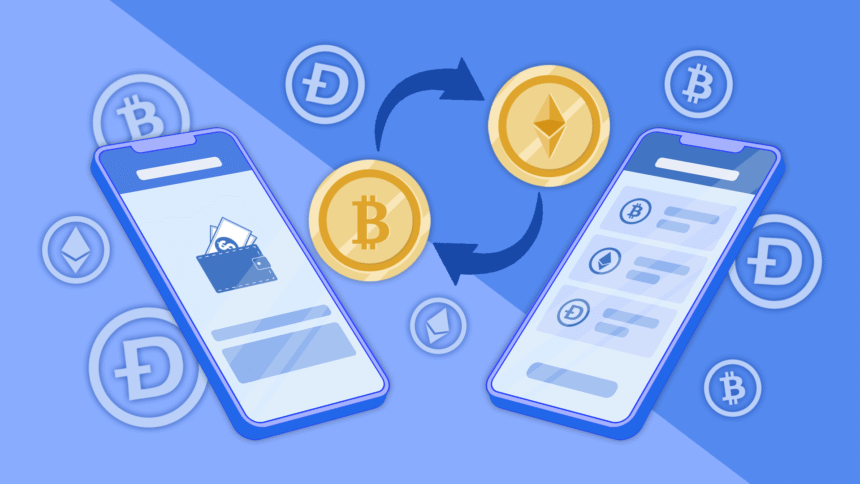The rapid growth of cryptocurrency has attracted millions of investors worldwide, seeking to benefit from the promise of decentralized finance and digital assets. However, with great opportunity comes significant risk. Cryptocurrency exchanges, which serve as the gateway for trading and storing digital assets, have been targeted by hackers and bad actors, resulting in millions of dollars in stolen funds.
This makes robust security measures essential to safeguarding your investments. In this post, we’ll explore the security measures employed by cryptocurrency exchanges, the threats faced by users and steps you can take to protect your digital assets.
1. Understanding Cryptocurrency Exchanges and Their Role
A cryptocurrency exchange is a platform that facilitates the buying, selling, and trading of cryptocurrencies. These exchanges act as intermediaries, enabling users to trade assets like Bitcoin, Ethereum, and altcoins in exchange for fiat currencies or other digital assets. There are two primary types of exchanges:
Centralized Exchanges (CEXs): These exchanges are run by companies that act as intermediaries, providing liquidity, order books, and security features. Examples include Binance, Coinbase, and Kraken.
- Advertisement -
Decentralized Exchanges (DEXs): Unlike centralized exchanges, DEXs operate on a peer-to-peer network, allowing users to trade directly with one another without intermediaries. Uniswap and SushiSwap are examples of DEXs.
2. Common Security Threats Facing Cryptocurrency Exchanges
Despite their popularity and widespread adoption, cryptocurrency exchanges are prime targets for cybercriminals due to the valuable assets they hold. Some of the most common threats include:
a) Hacking and Data Breaches
Many cryptocurrency exchanges have suffered high-profile hacking incidents, leading to the loss of user funds and sensitive data. Hackers use sophisticated techniques, such as phishing, malware attacks, and exploiting vulnerabilities in exchange software, to gain unauthorized access to user accounts.
b) Phishing Attacks
Phishing attacks involve tricking users into revealing their login credentials, private keys, or other sensitive information by impersonating legitimate websites or services. These attacks are often conducted via fake emails, social media messages, or cloned websites.
c) Insider Threats
Insider threats occur when employees or individuals with access to sensitive exchange data misuse their privileges to steal funds or compromise user accounts. Robust internal security measures are necessary to mitigate this risk.
d) Rug Pulls and Exit Scams
In decentralized exchanges, users may fall victim to “rug pulls,” where project developers suddenly withdraw liquidity or abandon a project, leaving investors with worthless tokens. Centralized exchanges may also experience exit scams if the operators abscond with user funds.
e) DDoS Attacks
Distributed Denial-of-Service (DDoS) attacks can overwhelm an exchange’s servers, making it temporarily inaccessible and disrupting trading activity. Such attacks can erode user confidence and expose the exchange to other security risks.
3. Key Security Measures Employed by Cryptocurrency Exchanges
To protect their users, reputable cryptocurrency exchanges employ a range of security measures designed to mitigate the risk of hacks, fraud, and unauthorized access. Here are some of the most common and effective measures:
a) Cold Storage Solutions
Cold storage refers to storing a majority of an exchange’s digital assets offline, away from internet access. By keeping funds in cold storage, exchanges minimize the risk of hackers gaining access to the majority of their assets.
- Hardware Wallets: Exchanges may use hardware wallets to store cryptocurrencies offline securely.
- Multi-Signature Wallets: These wallets require multiple private keys to authorize a transaction, reducing the risk of single-point failure.
b) Two-Factor Authentication (2FA)
2FA is an additional layer of security that requires users to provide two forms of verification before accessing their accounts. Typically, this involves something they know (password) and something they have (a one-time code sent to their mobile device). Popular methods include:
- SMS-based 2FA: Sends a one-time code via text message.
- App-based 2FA: Uses apps like Google Authenticator or Authy to generate time-based one-time passwords (TOTP).
- Hardware-based 2FA: Physical devices like YubiKeys provide an extra layer of security by requiring physical presence for authentication.
c) Encryption of Data
Strong encryption protocols ensure that sensitive data, such as user passwords and private keys, are protected from unauthorized access. Leading exchanges use encryption standards like SSL/TLS to secure data transmitted between users and the exchange.
d) KYC (Know Your Customer) and AML (Anti-Money Laundering) Compliance
To prevent illegal activities such as money laundering and fraud, most centralized exchanges require users to complete KYC procedures by verifying their identity through government-issued documents. AML compliance ensures that exchanges monitor and report suspicious transactions.
e) Multi-Signature Authorization for Withdrawals
Multi-signature wallets require multiple keys to authorize a withdrawal, making it difficult for a single individual or hacker to withdraw funds. This provides an added layer of security for large transactions.
f) Bug Bounty Programs
Many exchanges offer bug bounty programs that incentivize ethical hackers to identify and report vulnerabilities in their systems. This proactive approach helps exchanges identify potential security weaknesses before malicious actors can exploit them.
g) Regular Security Audits
Periodic security audits by independent third-party firms ensure that exchanges maintain strong security practices. These audits assess the exchange’s infrastructure, identify vulnerabilities, and recommend improvements.
h) DDoS Protection
To mitigate DDoS attacks, exchanges implement traffic-filtering solutions that detect and block malicious traffic. This ensures uninterrupted access to the exchange’s services and prevents disruptions to trading activities.
i) IP Whitelisting
Some exchanges allow users to whitelist specific IP addresses, ensuring that only authorized devices can access their accounts. If a login attempt is detected from an unapproved IP address, access is denied.
4. Best Practices for Protecting Your Digital Assets
While exchanges implement numerous security measures, users must also take responsibility for securing their accounts and digital assets. Here are essential steps to enhance your personal security:
a) Choose Reputable Exchanges
Before using an exchange, research its security history, user reviews, and compliance with regulations. Reputable exchanges prioritize security, offer insurance for user funds, and have a proven track record of handling security incidents transparently.
b) Enable Two-Factor Authentication (2FA)
Always enable 2FA for your exchange accounts. App-based 2FA is more secure than SMS-based 2FA because it is less susceptible to SIM-swapping attacks.
c) Use Strong, Unique Passwords
Create strong, unique passwords for each exchange account, combining letters, numbers, and symbols. Avoid using the same password across multiple sites. Consider using a password manager to securely generate and store complex passwords.
d) Be Wary of Phishing Attacks
Phishing is a common tactic used by attackers to steal user credentials. Always double-check the URL of the exchange’s website and be cautious of unsolicited emails or messages asking for your login details. Consider bookmarking the official exchange website to avoid visiting phishing sites.
e) Regularly Update Your Software
Keep your computer, mobile device, and any software used for trading up to date with the latest security patches. Cybercriminals often exploit outdated software to gain unauthorized access to user accounts.
f) Use Hardware Wallets for Long-Term Storage
For long-term storage of cryptocurrencies, consider using a hardware wallet. These devices store your private keys offline, reducing the risk of online attacks.
g) Enable Withdrawal Whitelisting
Withdrawal whitelisting restricts withdrawals to specific wallet addresses. Even if a hacker gains access to your account, they will be unable to withdraw funds to unauthorized addresses.
h) Monitor Your Account for Suspicious Activity
Regularly check your account for any unauthorized logins, withdrawal attempts, or changes to security settings. Promptly report any suspicious activity to the exchange’s support team.
i) Be Cautious with Mobile Apps
If using a mobile app to access your exchange account, only download official apps from trusted sources like the Apple App Store or Google Play Store. Be cautious of fake apps that may attempt to steal your credentials.
5. The Future of Cryptocurrency Exchange Security
As the cryptocurrency market continues to evolve, so too will the security measures needed to protect users. Emerging technologies and trends promise to further enhance security in the coming years.
a) Decentralized Identity Solutions
Decentralized identity systems can give users control over their personal data and eliminate the need for centralized identity verification processes, reducing the risk of data breaches.
b) Artificial Intelligence and Machine Learning
AI-driven security systems can detect and mitigate threats in real time, analyzing user behavior to identify anomalies and potential security breaches.
c) Zero-Knowledge Proofs
Zero-knowledge proofs (ZKPs) allow users to prove their identity or verify transactions without revealing sensitive information. This technology can enhance privacy and security for cryptocurrency users.
d) Multi-Party Computation (MPC) Wallets
MPC wallets divide private keys into multiple parts, stored across different devices. This approach reduces the risk of key compromise and provides an additional layer of security.
e) Cross-Chain Security Protocols
As users trade assets across multiple blockchains, cross-chain security protocols will ensure secure asset transfers and prevent vulnerabilities arising from interoperability.
6. Staying Vigilant in a Rapidly Changing Landscape
Cryptocurrency exchanges offer incredible opportunities for investors but also come with risks that must be carefully managed. By understanding the security measures employed by exchanges and taking personal precautions, users can protect their digital assets from theft and fraud. As the crypto space continues to mature, advances in security technology will play a pivotal role in safeguarding the future of decentralized finance. Stay informed, adopt best

